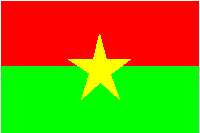
"There are many attractions of this stable country - which offers a thriving culture, laid-back cities, and wildlife encounters - including dramatic mask festivals, Fulani horse-dancing, and both the pan-African film festival in Siao and the craft fair in Fespaco, two of the largest events of their kind on the continent." - Burkina Faso Bradt Travel Guide
Capital Ouagadougou
Government Parliamentary system
Independence France, 1960
Population 14 million
Geography
The average altitude is 400 metres (1,300 ft) and the difference between the highest and lowest terrain is no greater than 600 metres (2,000 ft) - a relatively flat country. Burkina Faso has a primarily tropical climate with two very distinct seasons: the rainy season with between 24-35 inches of rainfall, and the dry season during which the harmattan blows, a hot dry wind from the Sahara. The rainy season lasts approximately 4 months, May/June to September, and is shorter in the north of the country. Water shortages are often a problem, especially in the north.
In general, the land is dry and poor.
Politics
Formerly Upper Volta, Burkina Faso has spent many of its post-independence years under military rule. After taking power in a 1983 coup, Thomas Sankara adopted a policy of nonalignment and gave the country its present name, which translates as "land of honest men". In 1987 Mr Sankara was overthrown and then executed in a coup masterminded by Blaise Compaore, who has since instituted a multi-party system.
Burkina Faso has faced domestic and external concern over the state of its economy and human rights, and allegations that it was involved in the smuggling of diamonds by rebels in Sierra Leone.
A rebellion in neighbouring Ivory Coast has raised tensions. Ivory Coast has accused Burkina Faso of backing rebels who hold the north of the country, a claim denied by Ouagadougou, which accuses its neighbour of mistreating Burkinabes living in Ivory Coast.
Economy
Burkina Faso is one of the poorest countries in the world, contributed to by its population growth and its arid soil. Agriculture represents 32% of its gross domestic product and occupies 80% of the working population. It consists mostly of livestock but also, especially in the south and southwest, of growing sorghum, millet, maize (corn), peanuts, rice and cotton.
There is mineral exploitation of copper, iron, manganese and, above all, gold. Burkina Faso has significant reserves of gold, but the production of cotton remains the economic mainstay for many Burkinabes. However, cotton is highly vulnerable to changes in world prices. Along with other African exporters it has lobbied against subsidies to cotton farmers in richer countries, particularly the US. It argues that these depress prices and restrict Burkinabe farmers' access to export markets.
The population is concentrated in the south and center of the country, sometimes exceeding 48 per square kilometre. This high population density, along with lack of work, causes annual migrations of hundreds of thousands for seasonal employment and a high rate of emigration - three million people from Burkina Faso live in Côte d'Ivoire. These migrants send tens of billions of CFA francs back to Burkina Faso each year.
A large part of the economic activity of the country is funded by international aid.
Besides traditional African religions, Islam and Christianity are also practised.
At 26.6%, Burkina Faso is the most illiterate country in Africa.
(edited. Wikipedia, BBC, The Africa Guide, Bradt)